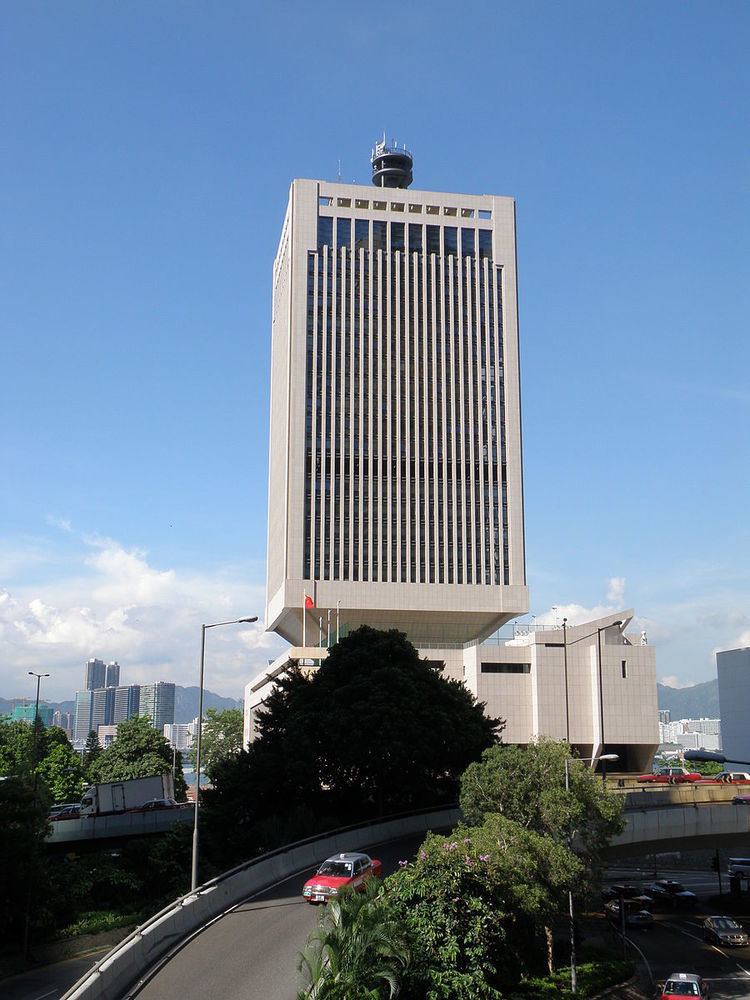Type Military Completed 1979 Floor count 28 Height 113 m Opened 1979 | Roof 113 m (371 ft) Address Hong Kong, Central, 愛丁堡廣場 Floors 28 | |
 | ||
Similar Stonecutters Island, Gun Club Hill Barracks, CITIC Tower, Jardine House, Bank of China Tower | ||
The Chinese People's Liberation Army Forces Hong Kong Building (abbreviated as PLA Forces Hong Kong Building) is a 113 metre (371 ft) tall, 28-floor building located within the former HMS Tamar naval base on Lung Wui Road, Admiralty, Hong Kong. It serves as the headquarters of the People's Liberation Army Hong Kong Garrison. The building is still popularly known by its old name as the Prince of Wales Building (威爾斯親王大廈) and is located adjacent to the Tamar site.
Contents
History
Constructed in 1979, the building was named the Prince of Wales Building. It housed the head office of the British Army stationed in Hong Kong until the territory's handover to the People's Republic of China on 1 July 1997 when it was made the head office of the PLA Hong Kong Garrison. In May 2000, the Legislative Council of Hong Kong passed the Military Installations Closed Areas (Amendment) Order 2000, which renamed the former Prince of Wales Barracks to Central Barracks, and the Prince of Wales Building to the Chinese People's Liberation Army Forces Hong Kong Building. After the base became the Central Barracks, the old name of the building remained visible in large raised letters along the bottom of the tower for several years. The building underwent a 20-month full renovation, completed in 2014, during which most of the troops have been transferred to the Stonecutters Island base.
Due to its distinctive shape, likened to a wineglass, the building stands out from the rest of the Admiralty waterfront buildings. Architects attribute the shape of the building to passive protection, its narrow stem with the protruding upper storeys, supposedly makes it difficult to climb or attack. It is also informally known as 'the upside-down Gin bottle due to its shape resembling a bottle of Gordon's Gin. The corner of the building at the podium level which faces east (towards Admiralty MTR station) used to be a chapel under British use of the barracks. There used to be a crucifix visible on the exterior—however, during external refurbishment (including replacing the 'Prince of Wales Building' inscription in English with its current name in Chinese), the cross was removed.
In late 2013, Hong Kong independence activists stormed the building during renovation demanding the removal of a red star which they felt was a symbol of the Chinese Communist Party's (CCP) interference in Hong Kong. They marched demanding that Hong Kong become a genuine sovereign state and that the People's Liberation Army leave Hong Kong, while waving the British Hong Kong flag.
People's Liberation Army in Hong Kong
The PLA maintains a number of garrisons in the Hong Kong Special Administrative Region. In addition to the PLA Forces Hong Kong Building, there are notable garrisons at the Stonecutters Island, and at Stanley Fort. Soldiers located at these three garrisons are considered to be the élite of the PLA. The soldiers are not permitted to leave their compounds, even during off-duty times to mingle with the local populace. As a military property, the PLA Forces Hong Kong Building is heavily guarded by very alert soldiers with machine guns. It is best to photograph it from somewhere along Harcourt Road and not to attract too much attention.
